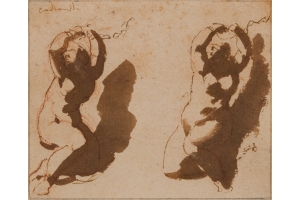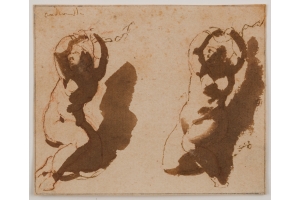

Jan de Bisschop was the son of Harmen Jansz. de Bisschop and Aaltje Adriaensz. van Noort. Jan preferred to call himself Episcopius as he had a strong preference for the latin language. He is assumed to have been an apprentice of Bartholomeus Breenbergh (Deventer, 1598-Amsterdam, 1657), though he was a dillettante. Jan studied Law in Leyden after which he settles as a lawyer in The Hague in 1652. He married Anna van Baerle (1615-1676) in 1653. In The Hague de Bisschop held close connections and friendship with the Huygens family, especially with Constantijn Huygens Jr (1628-1697).
Together with Jacob van der Does Sr., Maerten Lengele, Willem Doudijns and probably Constantijn Huygens Jr. as well, Jan de Bisschop founded a private drawing academy to promote Classicism.
De Bisschops most important publications on Claccisism would follow several years later with Signorum veterum Icones after classical sculptures in Rome and Paradigmata Graphices Variorum Artificium with etchings after drawings by Italian Masters. This second publication unfortunately unfinished due to de Bisschops premature death.[2]
Jan de Bisschop died of tuberculosis in 1671, after which his drawings and prints were auctioned. The copper plates for his etchings were purchased by Nicolaus Visscher who published a new edition of his graphics (Icones and Paradigmata).
Our sheet with two studies of Andromeda shows the story of Andromeda, daughter of Cepheus and the vain Cassiope, who was supposed te be sacrificed due to her mother's boasting she was more beautiful than the Nereids. On their turn, the Nereids invoked the help of the God of the sea, Poseidon to destroy the ralm of Cassiope's husband, King Cephius of Ethiopia. According to the Oracle of Delphi, the only way the couple could appease the sea god was by sacrificing their ravishing and virgin daughter Andromeda to the sea monster Cetus. Perseus, who had just killed Medusa, flying overhead on his winged horse Pegasus, saw Andromeda and fell in love with her right away and decided to save her by killing Cetus, claiming Andromeda in return.
The same repetitive motif of studies we see in one of Jan de Bisschop's sheets with studies in the coll. University Göttingen.[3]
[1] Renske E. Jellema, Michiel Plomp, Episcopius / Jan de Bisschop; advocaat en tekenaar / lawyer and draughtsman. Waanders Uitgevers, Zwolle / Museum het Rembrandthuis, Amsterdam, 1992.
[2] Jan de Bisschop, Jan G. van Gelder, I. Jost, Jan de Bisschop and his Icones & Paradigmata. Classical Antiquities and Italian Drawings for Artistic Instruction in Seventeenth Century Holland. Davaco Publishers, Doornspijk, 1985.
[3] Jan de Bisschop, Chronos, cutting off Cupid's wings. Pen and brown ink, brown wash, 89 x 203 mm. Kunstsammlung der Universität Göttingen, Göttingen (Niedersachsen) , inv./cat.nr Sammlung Uffenbach H 26.